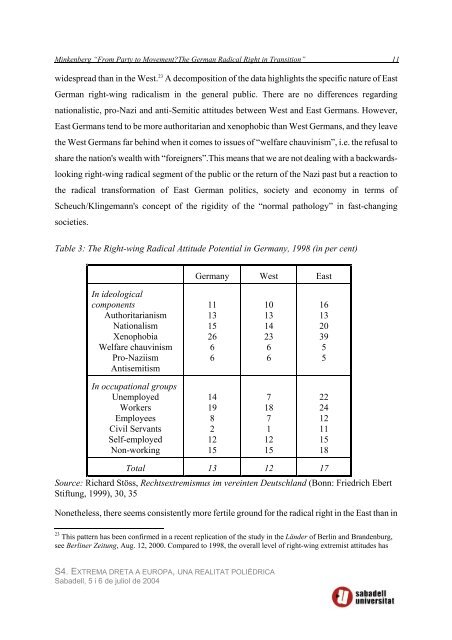From Party to Movement? The German Radical Right
From Party to Movement? The German Radical Right
From Party to Movement? The German Radical Right
Create successful ePaper yourself
Turn your PDF publications into a flip-book with our unique Google optimized e-Paper software.
Minkenberg “<strong>From</strong> <strong>Party</strong> <strong>to</strong> <strong>Movement</strong>?<strong>The</strong> <strong>German</strong> <strong>Radical</strong> <strong>Right</strong> in Transition” 11<br />
widespread than in the West. 23 A decomposition of the data highlights the specific nature of East<br />
<strong>German</strong> right-wing radicalism in the general public. <strong>The</strong>re are no differences regarding<br />
nationalistic, pro-Nazi and anti-Semitic attitudes between West and East <strong>German</strong>s. However,<br />
East <strong>German</strong>s tend <strong>to</strong> be more authoritarian and xenophobic than West <strong>German</strong>s, and they leave<br />
the West <strong>German</strong>s far behind when it comes <strong>to</strong> issues of “welfare chauvinism”, i.e. the refusal <strong>to</strong><br />
share the nation's wealth with “foreigners”.This means that we are not dealing with a backwards-<br />
looking right-wing radical segment of the public or the return of the Nazi past but a reaction <strong>to</strong><br />
the radical transformation of East <strong>German</strong> politics, society and economy in terms of<br />
Scheuch/Klingemann's concept of the rigidity of the “normal pathology” in fast-changing<br />
societies.<br />
Table 3: <strong>The</strong> <strong>Right</strong>-wing <strong>Radical</strong> Attitude Potential in <strong>German</strong>y, 1998 (in per cent)<br />
In ideological<br />
components<br />
Authoritarianism<br />
Nationalism<br />
Xenophobia<br />
Welfare chauvinism<br />
Pro-Naziism<br />
Antisemitism<br />
In occupational groups<br />
Unemployed<br />
Workers<br />
Employees<br />
Civil Servants<br />
Self-employed<br />
Non-working<br />
Total<br />
<strong>German</strong>y<br />
11<br />
13<br />
15<br />
26<br />
6<br />
6<br />
14<br />
19<br />
8<br />
2<br />
12<br />
15<br />
West<br />
10<br />
13<br />
14<br />
23<br />
6<br />
6<br />
S4. EXTREMA DRETA A EUROPA, UNA REALITAT POLIÈDRICA<br />
Sabadell, 5 i 6 de juliol de 2004<br />
13<br />
Source: Richard Stöss, Rechtsextremismus im vereinten Deutschland (Bonn: Friedrich Ebert<br />
Stiftung, 1999), 30, 35<br />
Nonetheless, there seems consistently more fertile ground for the radical right in the East than in<br />
23 This pattern has been confirmed in a recent replication of the study in the Länder of Berlin and Brandenburg,<br />
see Berliner Zeitung, Aug. 12, 2000. Compared <strong>to</strong> 1998, the overall level of right-wing extremist attitudes has<br />
7<br />
18<br />
7<br />
1<br />
12<br />
15<br />
12<br />
East<br />
16<br />
13<br />
20<br />
39<br />
5<br />
5<br />
22<br />
24<br />
12<br />
11<br />
15<br />
18<br />
17













